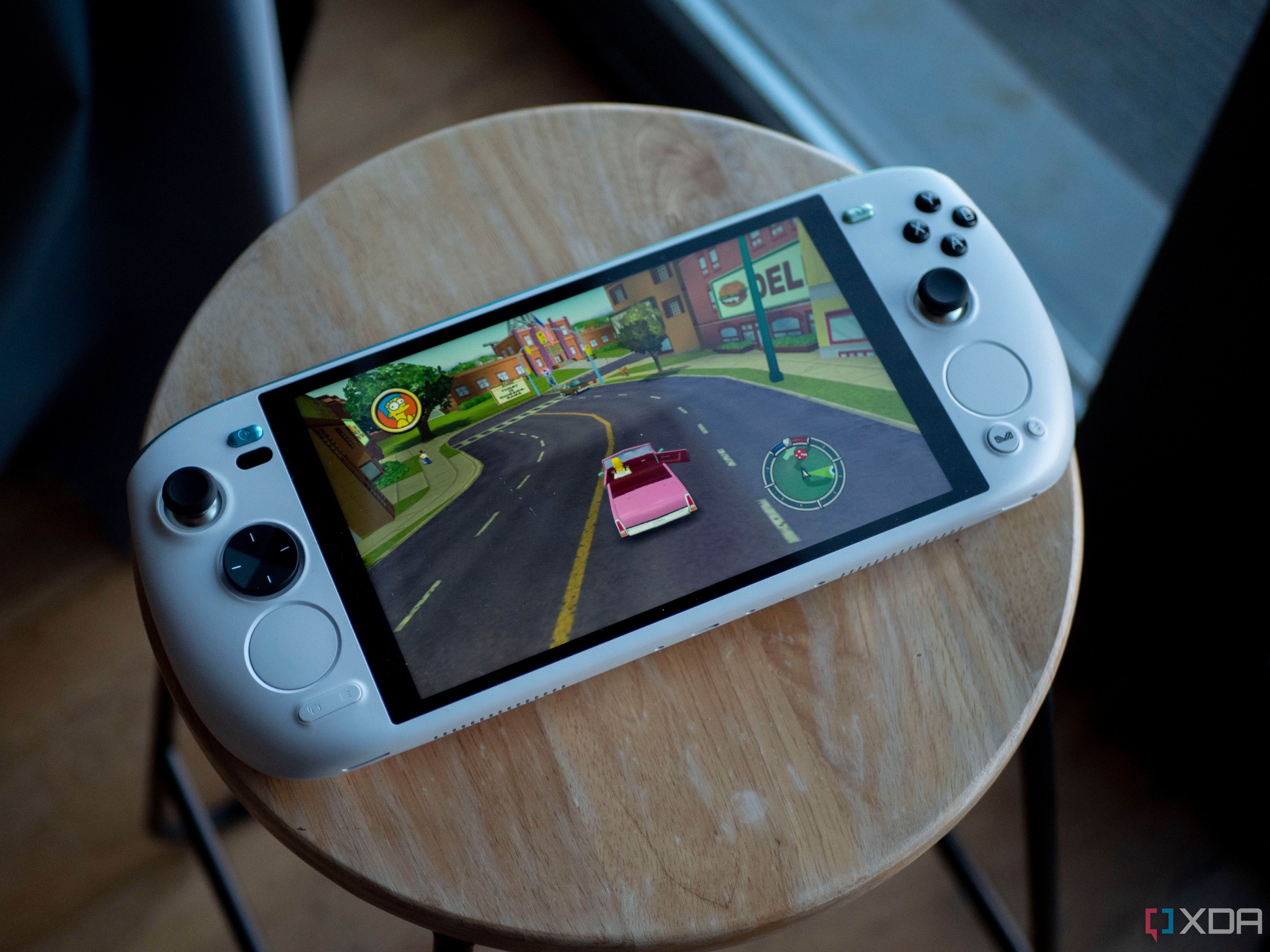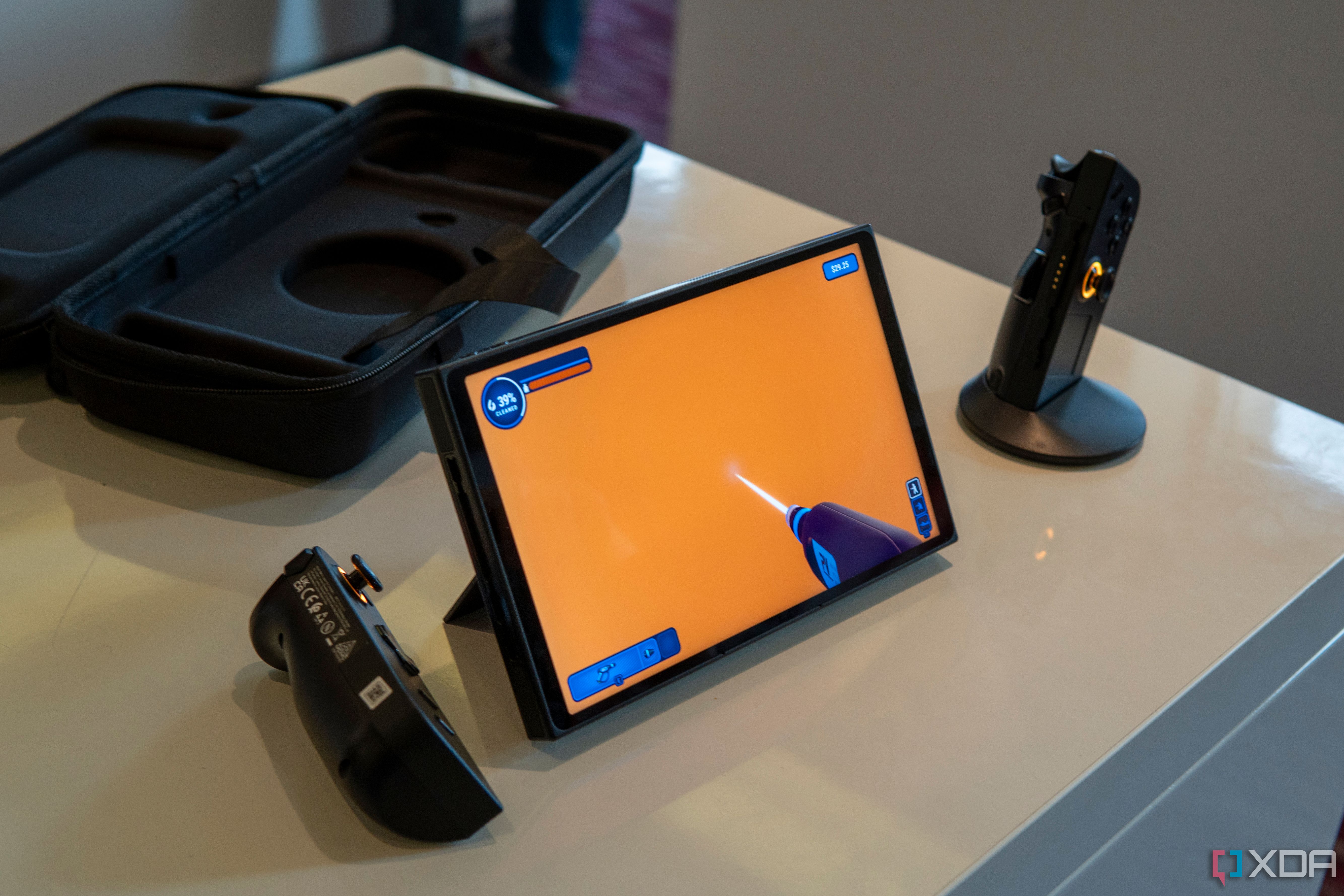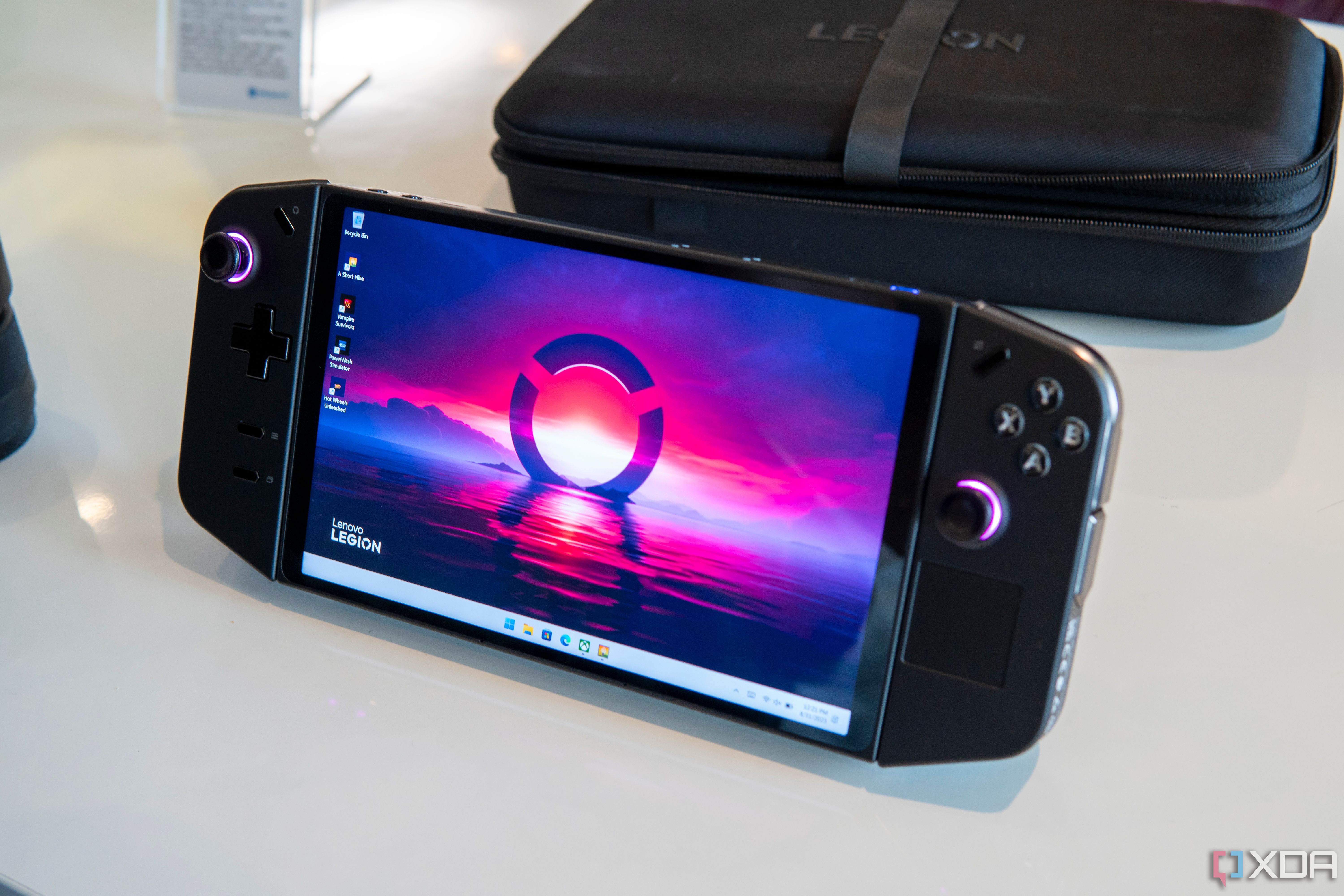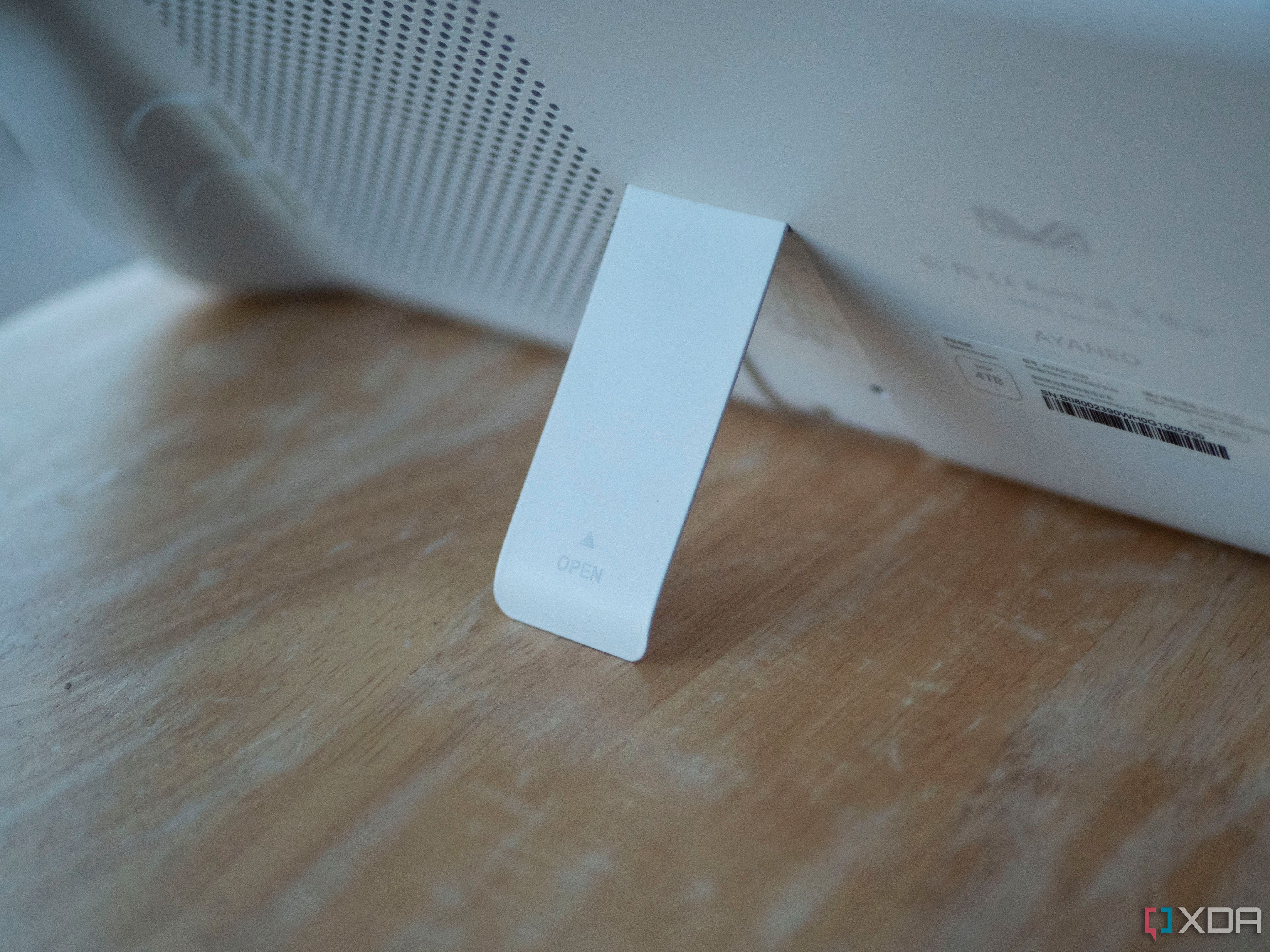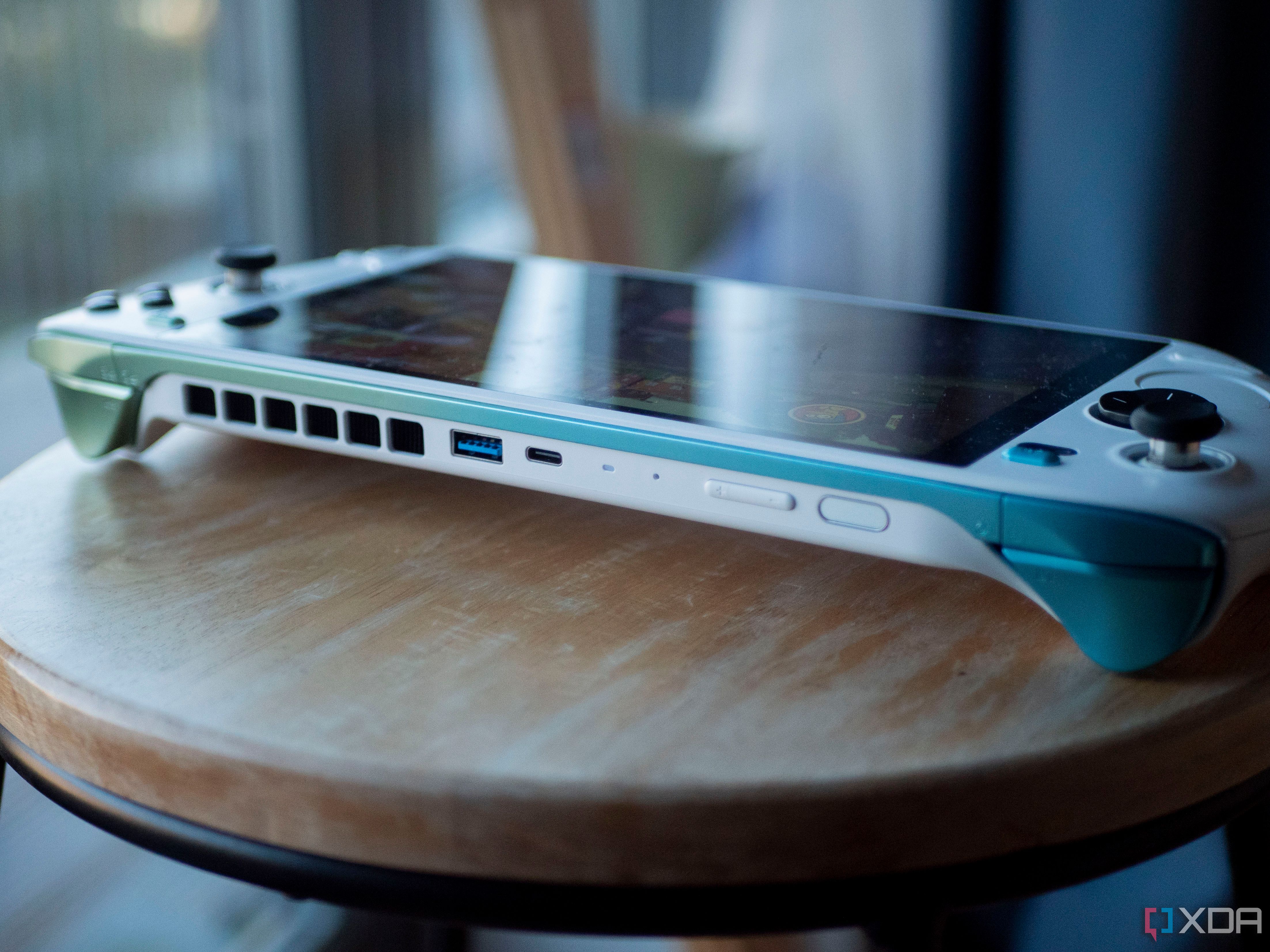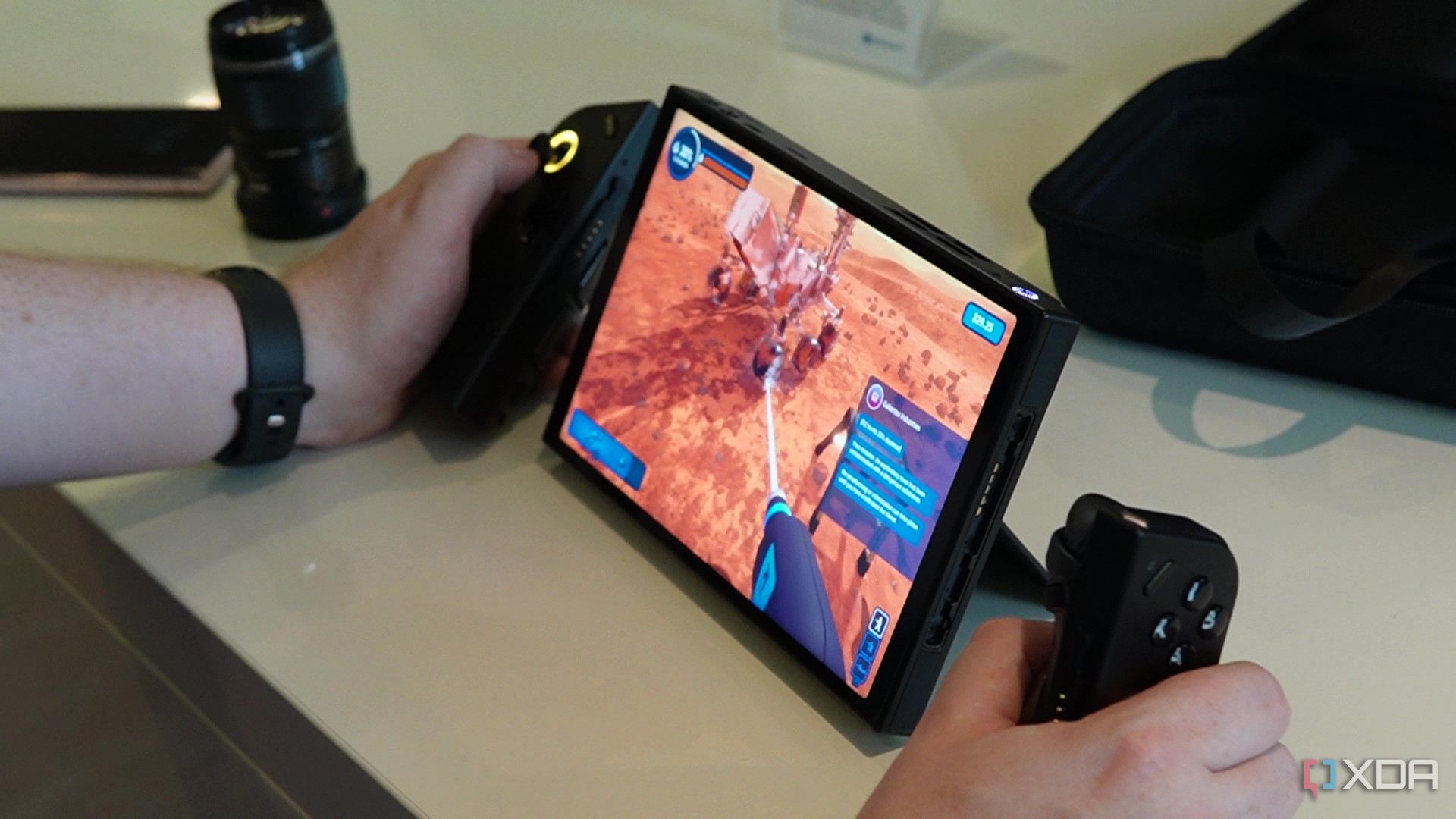-
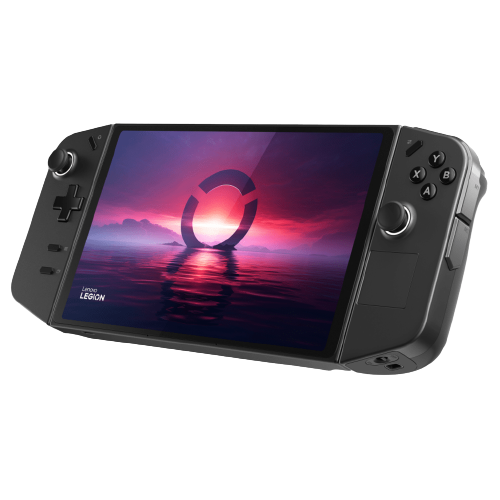
Lenovo Legion Go
Bigger Screen
Lenovo’s Legion Go offers gamers a sleek and powerful handheld console, featuring an impressive 8.8-inch display with a 144Hz refresh rate, an AMD Ryzen Z1 Extreme processor, and up to 16GB of RAM, making it a contender for on-the-go gaming.
Pros- Detachable controllers and mouse
- 8.8-inch bigger display
- 97% DCI-P3 coverage
Cons- Still using conventional RAM
-
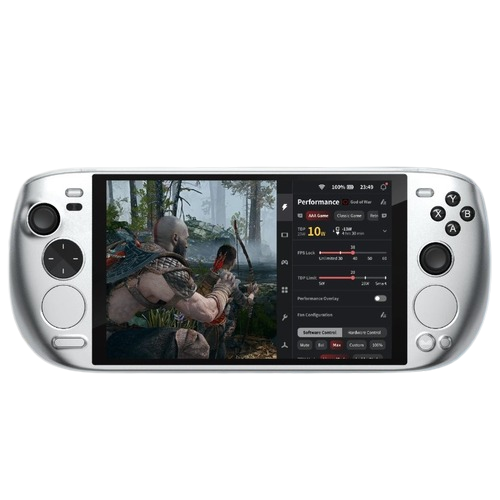
Source: Ayaneo
Ayaneo KUN
Ultimate handheld gaming console
$999 $1209 Save $210
Ayaneo Kun takes handheld gaming to new heights. With a robust heat dissipation system, various RAM options up to 64GB, up to 4TB of storage, it caters to gamers seeking top-notch performance.
Pros- Multiple RAM and storage options
- Better battery power handling
- Great thermal performance
Cons- Price is on the higher side
The Ayaneo Kun, one of the newest handheld gaming consoles, is a great device. It can hold its own against the Asus ROG Ally, Steam Deck, and many others. But, where does it stand with Lenovo’s latest, the Legion Go? Let’s get a head-to-head comparison of both devices to help you decide on your next handheld gaming console. We’ve covered several aspects including design, performance, display, and battery as well.
Pricing and availability
The Lenovo Legion Go offers a competitive pricing structure. It comes in two variants, with the 512GB variant priced at $700 and the 1TB variant at $750.
As for the Ayaneo Kun, it begins at $1,209 for the base configuration, featuring 16GB of RAM and a 512GB storage capacity. The range extends up to $1,949 for the top-tier model equipped with 64GB of RAM and 4TB SSD. Keep in mind that you can choose from a variety of RAM and storage options, including 16GB+512GB, 32GB+1TB, 32GB+2TB, and the top variant: 64GB+4TB.
It is important to know that there’s an early bird discount on the regular prices. You can get the 16GB RAM and 512GB storage variant for $999 while the top-of-the-line model (65GB+4TB) is available for $1,699 at the time of this article being written.
As for the colors, Ayaneo Kun gives more of a choice compared to the Lenovo Legion Go. Ayaneo Kun is offered in black, white, and silver, while the Legion Go is available only in black.
-
Lenovo Legion Go Ayaneo KUN Weight Starting at 1.41 pounds (640 grams) 900g Chipset Up to AMD Ryzen Z1 Extreme (8 cores, 16 threads, up to 5.1GHz, 16MB L3 cache) Ryzen 7840U RAM 16GB LPDDR5x 7500Mhz Up to 64GB Storage 256GB, 512GB, 1TB PCIe 4.0 NVMe M.2 2242 SSD Up to 4TB Display 8.8-inch IPS, 16:10 aspect ratio, Quad HD+ (2560×1600), 144Hz refresh rate, 97% DCI-P3, 500 nits, touch 8.4 inches 1600p Graphics AMD RDNA 3 Graphics (up to 12 cores) Radeon 780M Ports 2x USB4 (one on top, one at the bottom) 3.5mm headphone jack microSD card reader 2x USB-C, 1x USB-A, 1x 3.5mm, 1x microSD Battery Main unit: 49.2Whr battery with Super Rapid Charge/ Controllers: 900mAh battery 75WHr
Performance
The Lenovo Legion Go showcases its power with an AMD Ryzen Z1 Extreme processor, capable of reaching clock speeds from 3.3GHz to an impressive 5.1GHz. This processor brings formidable gaming performance to the table, although it’s essential to maintain realistic expectations — it won’t outperform a full-fledged gaming laptop/desktop but should handle most modern games with some graphics tweaks. But, we can still say that the AMD Radeon graphics offer a reliable graphics solution for gaming on the go.
However, a potential downside of the Lenovo Legion Go lies in its storage. It employs M.2 2242 SSDs, which are not as standardized as the M.2 2230 SSDs found in the Steam Deck and Asus ROG Ally. This unconventional choice might make it more challenging to find SSD upgrades in the future. The Ayaneo Kun also incorporates M.2 2280 SSDs.
On the flip side, the Ayaneo Kun lives up to its promise. With an AMD Ryzen 77840U CPU, performance will never be a problem. Ayaneo’s “KUNPeng” heat dissipation system is the key highlight here. It offers flexibility with TDP settings, going all the way up to a staggering 54W. You can ramp up the TDP according to your preference from the AYA Space (software), but obviously, this would drain more battery too. While the Lenovo Legion Go also has a heat dissipation system, it can only go up to 30W TDP giving the Ayaneo a clear lead here.
Secondly, a major aspect to consider is the RAM. The Lenovo Legion Go is equipped with 16GB of LPDDR5X RAM, which is nothing to scoff at. But, the Ayaneo Kun offers variable RAM options including 16/32/64GB. This breadth of choices caters to gamers who demand exceptional performance and the ability to handle even the most graphically demanding and resource-hungry games with ease.
According to some performance tests conducted by XDA for Ayaneo Kun, it was evident that gaming at 54W TDP led to substantial heat and battery consumption. Surprisingly, there were diminishing returns as TDP levels increased. The testing showed that playing at lower TDP levels provided reasonable performance without excessive battery drain.
Display
When it comes to the display, The Lenovo Legion Go takes the lead with its larger 8.8-inch IPS display plus a swift 144Hz refresh rate for smooth gameplay. The Ayaneo Kun features a slightly smaller 8.4-inch IPS screen, though it matches the Legion Go with a bright 500-nit peak brightness.
An interesting point: Both devices feature the same pixel resolution of 2560×1600. That being said, the Ayaneo Kun will have a slightly higher pixel-per-inch density compared to the Lenovo Legion Go because of the smaller screen size.
The Legion Go gets extra points for an extensive 97% DCI-P3 color gamut coverage. As for Ayaneo Kun, it offers 130% of the sRGB color volume and 100% sRGB color gamut, but it falls a bit short in DCI-P3 coverage at 90%.
If you prioritize a larger, higher-resolution display with extensive color accuracy, I’d say you go for Lenovo Legion Go, but if you are looking for a more compact option, the Ayaneo Kun is fine too. Both devices offer the same pixel resolution, so the real choice (in this department) comes down to the display size.
Design
When it comes to design, both devices are on their A Game. The Ayaneo Kun, with its weight of 950 grams, is noticeably heftier, but it packs a lot of unique features that cater to serious gamers. It offers a comfortable and sturdy build quality, with a soft-touch plastic exterior that’s easy on the hands. This ergonomic design, reminiscent of the Steam Deck, ensures balanced weight distribution and ease of use.
Plus, it has bigger grips, dual touchpads with four distinct buttons underneath each, and quad back buttons creating a controller layout that provides a lot of flexibility for various gaming styles. The addition of Hall Effect joysticks and triggers helps prevent drift issues, a common problem in some gaming devices. Ayaneo doesn’t overlook practicality either, adding a Windows Hello front-facing camera for face login and streaming, a 4G module for cellular connectivity, and a hidden nano-SIM slot under the kickstand.
There are also numerous ports, including USB-C, USB-A, microSD, and a headphone jack, making it versatile and well equipped. Additionally, you’ll find bottom-firing speakers on both ends, alongside improved haptics compared to its predecessor, the Ayaneo 2S, making it a value-added package. On the downside, we found in our review of the Ayaneo Kun, the kickstand’s adjustability is somewhat limited. It worked well for slightly lowered surfaces, but if one needed to tilt the device for better visibility, it became a bit cumbersome. Also, some of the button placements were a bit perplexing. The top left and right buttons looked like they should be the start and select buttons, but they served different functions.
The Lenovo Legion Go, in contrast, is a bit lighter at 640 grams, which enhances its portability. Its design focuses on providing flexibility and innovation for gamers. Size doesn’t always mean weight, and the Lenovo Legion Go and Ayaneo Kun are perfect examples of this statement. I noticed that the Lenovo Legion Go offers a bigger 8.8-inch screen while keeping its weight at a minimal 640 grams, whereas the Ayaneo Kun, with a slightly smaller screen, brings up some extra weight at 900 grams. This is probably because the Ayaneo Kun has better battery specs, but more about that later.
A unique aspect of the Legion Go is the ability to use the controllers independently of the main body. This flexibility extends to charging, as the controllers recharge when attached to the console. While the controllers may take some getting used to for detachment, they offer a similar experience to the Nintendo Switch’s Joy-Cons. When attached, the controllers are sturdy and provide a comfortable grip. Either way, I must say, it’s a really cool approach.
I also noticed that Lenovo introduced an intriguing feature with its FPS mode, utilizing an optical mouse sensor on the right controller, akin to a traditional mouse. This feature is particularly appealing to competitive gamers who prefer a more precise aiming experience. It was a competitive advantage and something I hadn’t experienced with other handheld gaming devices.
The device includes a mouse wheel on the back of the controller, enhancing navigation in Windows 11. The Legion Go also provides several physical buttons and a touchpad for navigation and gameplay, giving gamers a wide range of options.
Battery
When it comes to battery, the Ayaneo Kun is a straight winner. Not only does it outperform Lenovo Legion Go, but it even surpasses what we’ve seen with the Asus Rog Ally and Steam Deck. The Ayaneo Kun stands out with its impressive battery capacity, packing a substantial 75WHr. The device claims to last nearly 3.25 hours at a 15W TDP.
The Ayaneo Kun also features a new “KUNPeng” heat dissipation system, which plays a role in maintaining thermal efficiency during gaming. It enables the APU to operate at higher wattages, with turbo mode reaching up to an impressive 54 watts. This turbo mode significantly surpasses the 30-watt turbo mode on the Asus ROG Ally, emphasizing the Ayaneo Kun’s commitment to delivering exceptional gaming performance.
The Lenovo Legion Go, in contrast, is equipped with a two-cell 49.2WHr battery. However, it features the Super Rapid Charge feature for quick charging via a 65W USB Type-C power adapter.
In addition to the device’s battery capacity, it’s worth noting that the Lenovo Legion Go includes a separate battery for the controllers with a capacity of 900mAh. It is worth noting that both devices have juice-consuming processors, especially the AMD Ryzen Z1 Extreme in the Legion Go.
Which gaming console should you go for?
Both devices bring their unique strengths and cater to different gaming preferences, but when all the elements are weighed, the Ayaneo Kun appears to have a slight edge.
The two gaming consoles offer close competition in terms of processors, but the difference comes in terms of storage and RAM options: Ayaneo takes the clear lead here with several RAM options while Lenovo sticks to the 16GB. Plus, the battery of Ayaneo Kun is far better along with better thermal performance. On top of that, the display specs are more or less the same, with the Ayaneo having better PPI compared to Lenovo. Speaking as a gamer, these features are more than enough for me to decide that Ayaneo should be my next handheld gaming console.

Source: Ayaneo
Ayaneo KUN
Editor’s pick
$999 $1209 Save $210
The Ayaneo Kun is a clear winner of this battle. With more storage options, enhanced RAM capabilities, heat dissipation system, and amazing battery power, the Ayaneo Kun is surely one of the best gaming consoles out there and an exceptional Steam Deck alternative.
But, for a fair shot to Lenovo Legion Go, the design is really amazing. The screen size is bigger, and the detachable controllers are pretty sick. It is also lighter and cheaper than the Ayaneo Kun. That being said, if you are short on money, the Lenovo Legion Go is also a great pick.

Lenovo Legion Go
Runner-up
Lenovo’s Legion Go offers an AMD Ryzen Z1 Extreme processor and formidable gaming performance. It features an 8.8-inch display with a swift 144Hz refresh rate for immersive gameplay. The detachable controllers and FPS mode add a unique dimension to the gaming experience.
[ad_2]


